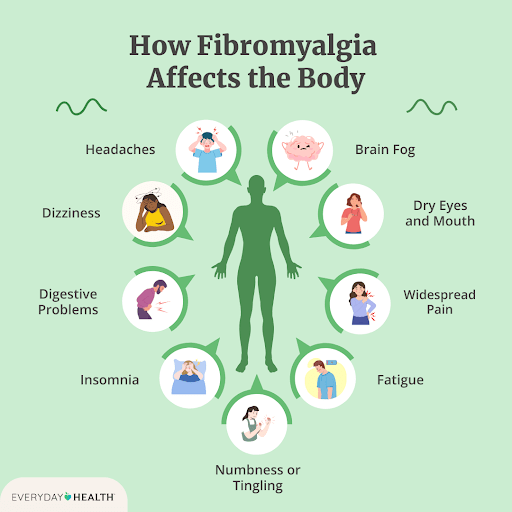If you’ve ever been told, “It’s all in your head,” after describing chronic body pain, fatigue, or mental fog—you’re not alone. For years, Fibromyalgia was misunderstood, dismissed, or misdiagnosed. But today, science has a clearer understanding of this complex condition, and the good news is: it’s real, and it’s treatable.

What Is Fibromyalgia?
Fibromyalgia is a chronic pain disorder that affects the muscles and soft tissues. It’s characterized by widespread musculoskeletal pain, often accompanied by fatigue, sleep disturbances, memory issues (commonly called “fibro fog”), mood disorders, and heightened pain sensitivity.
Unlike injuries that show up on X-rays or blood tests, fibromyalgia doesn’t cause visible inflammation or tissue damage, which is why it has been so hard to diagnose and treat.

What Causes Fibromyalgia?
While the exact cause is still being studied, researchers believe fibromyalgia stems from a dysfunction in the way the nervous system processes pain—a condition known as central sensitization.
In simple words, the pain signals are amplified in the brain and spinal cord, making normal sensations (like a gentle touch or minor strain) feel extremely painful.
Triggers and risk factors include:
- Physical trauma or surgery
- Emotional stress or PTSD
- Viral infections
- Genetics (runs in families)
- Coexisting conditions like arthritis or lupus

Common Symptoms of Fibromyalgia
People with fibromyalgia often experience:
- Persistent, dull aching pain in muscles and joints
- Morning stiffness
- Fatigue even after a full night’s sleep
- Brain fog – difficulty focusing, concentrating, or remembering
- Headaches or migraines
- Irritable bowel symptoms
- Anxiety or depression
Every patient’s experience is unique—and that’s why a personalized, multi-disciplinary approach to treatment works best.


Diagnosing Fibromyalgia: It’s Not All in Your Head
There’s no single test for fibromyalgia. Diagnosis is made based on:
- Patient history
- Presence of symptoms for over 3 months
- Ruling out other medical conditions
- Widespread pain index and symptom severity score
Many patients go years without a diagnosis, often mislabelled as having depression, arthritis, or just “stress-related pain.”
That’s why it’s important to see a pain specialist or rheumatologist familiar with fibromyalgia.

How Is Fibromyalgia Treated?
While there is no cure, a combination of treatments can significantly reduce symptoms and improve quality of life:

Medications
- Neuromodulators like pregabalin or duloxetine
- Muscle relaxants or low-dose antidepressants

Physical Therapy
- Gentle stretching, posture correction, hydrotherapy, and strengthening exercises

Pain Management Interventions
- At ALGOS Multispeciality Pain Clinic, we offer Trigger point injections, Joint injections, Infusions etc. which has shown promising results in reducing chronic pain and inflammation

Lifestyle Changes
- Regular low-impact exercise like walking or swimming
- Yoga
- Sleep hygiene and stress management

Cognitive Behavioral Therapy (CBT)
- For dealing with associated anxiety, mood changes, and pain perception

Living with Fibromyalgia: You’re Not Alone
Chronic pain can be isolating. But remember: fibromyalgia is real, and with the right guidance, it is manageable.
At ALGOS Multispeciality Pain Clinic, we believe in a holistic, compassionate approach to managing fibromyalgia. We work with patients not just to reduce pain, but to reclaim their energy, function, and joy.
If you or a loved one is living with unexplained body pain and fatigue, don’t brush it off. Consult with our Pain Specialist at ALGOS Multispeciality Pain Clinic and take the first step toward healing.
Have questions about fibromyalgia or want to book an appointment? Contact us at 7975896550 or info@algospainclinic.com.

REFERENCES
- Walitt B, Nahin RL, Katz RS, Bergman MJ, Wolfe F. The Prevalence and Characteristics of Fibromyalgia in the 2012 National Health Interview Survey. PLoS One. 2015;10(9):e0138024.
- Goldenberg DL. Fibromyalgia syndrome. An emerging but controversial condition. JAMA. 1987 May 22-29;257(20):2782-7.
- Clauw DJ. Fibromyalgia: a clinical review. JAMA. 2014 Apr 16;311(15):1547-55. [
- Ben-Ami Shor D, Weitzman D, Dahan S, Gendelman O, Bar-On Y, Amital D, Shalev V, Chodick G, Amital H. Adherence and Persistence with Drug Therapy among Fibromyalgia Patients: Data from a Large Health Maintenance Organization. J Rheumatol. 2017 Oct;44(10):1499-1506.





